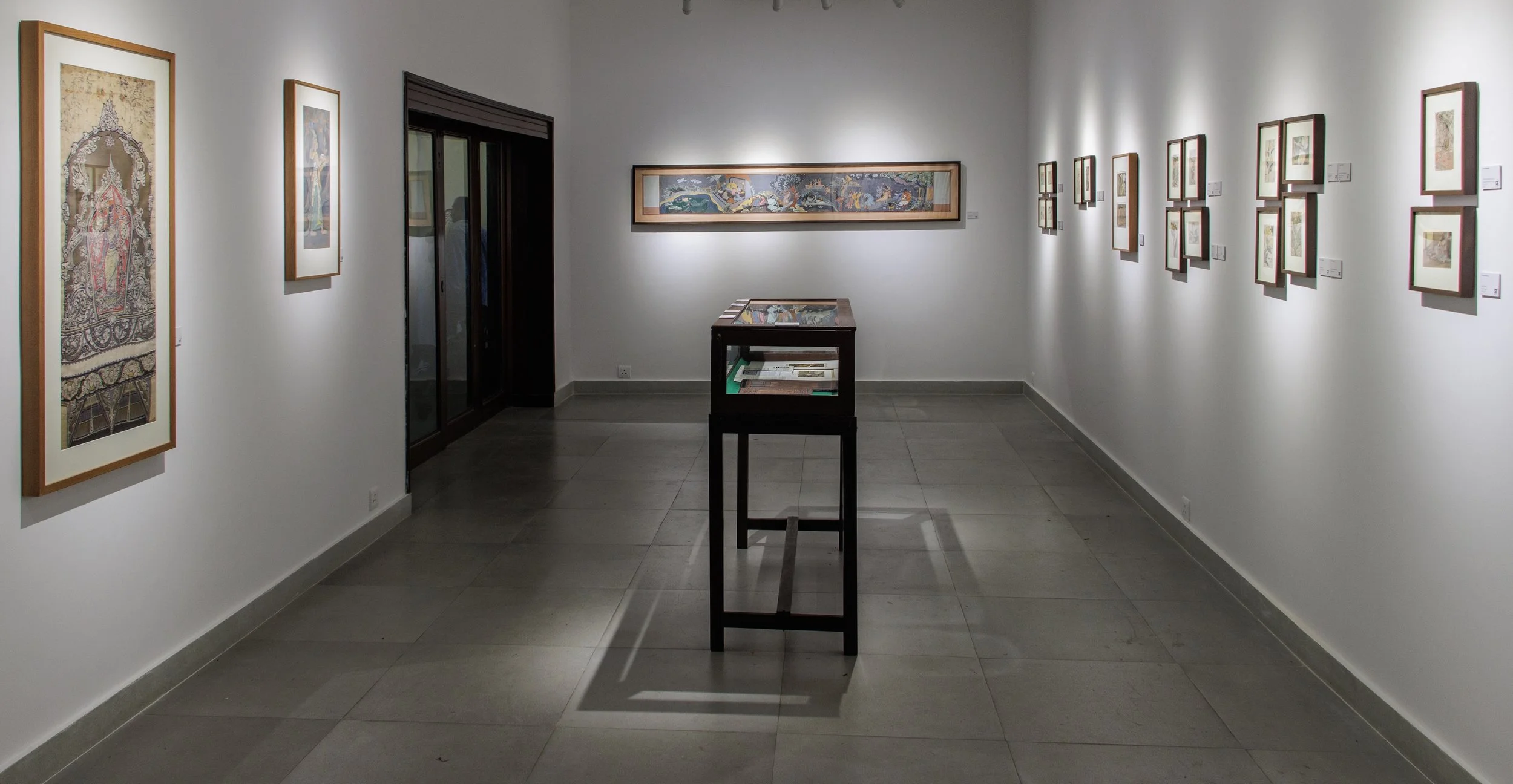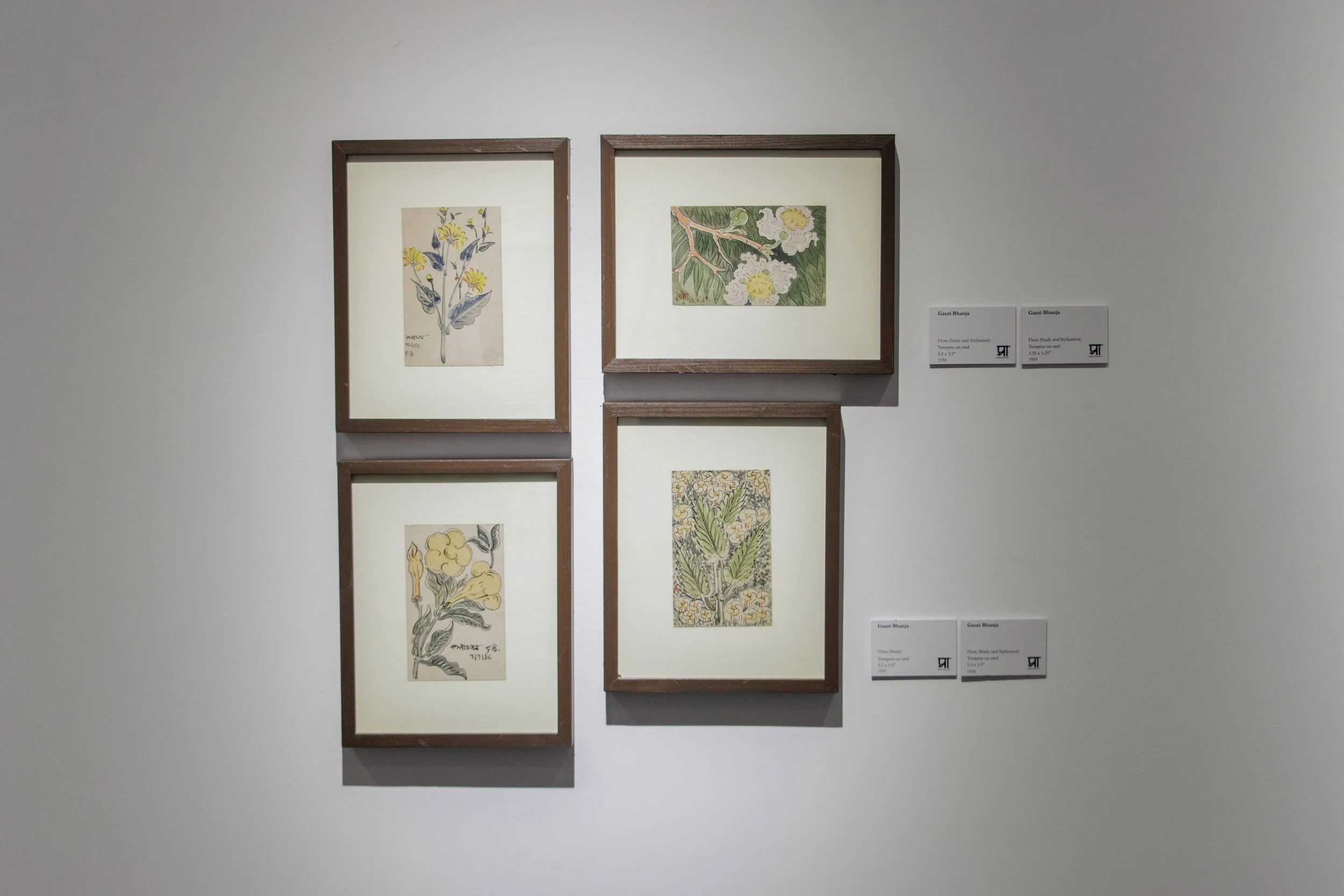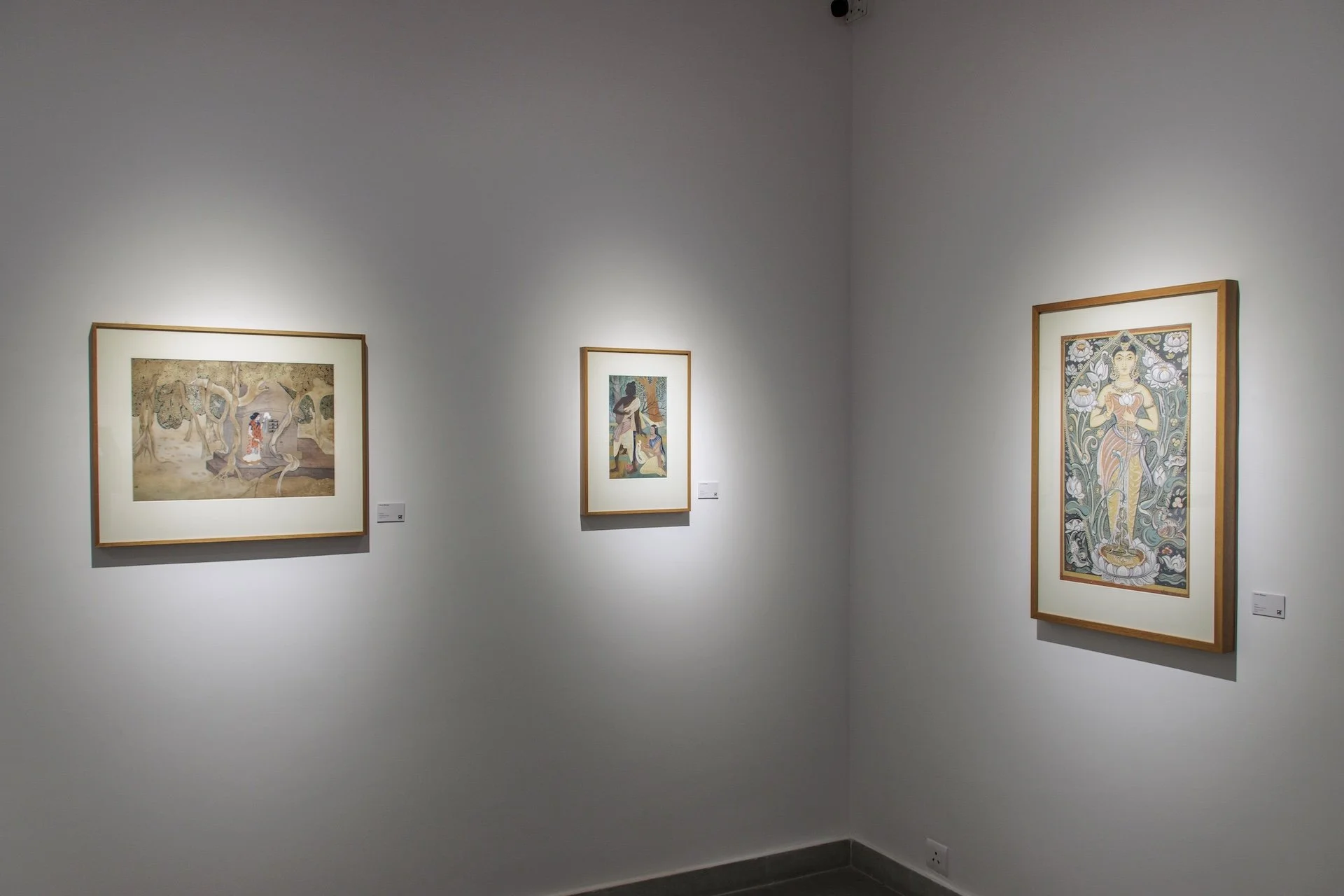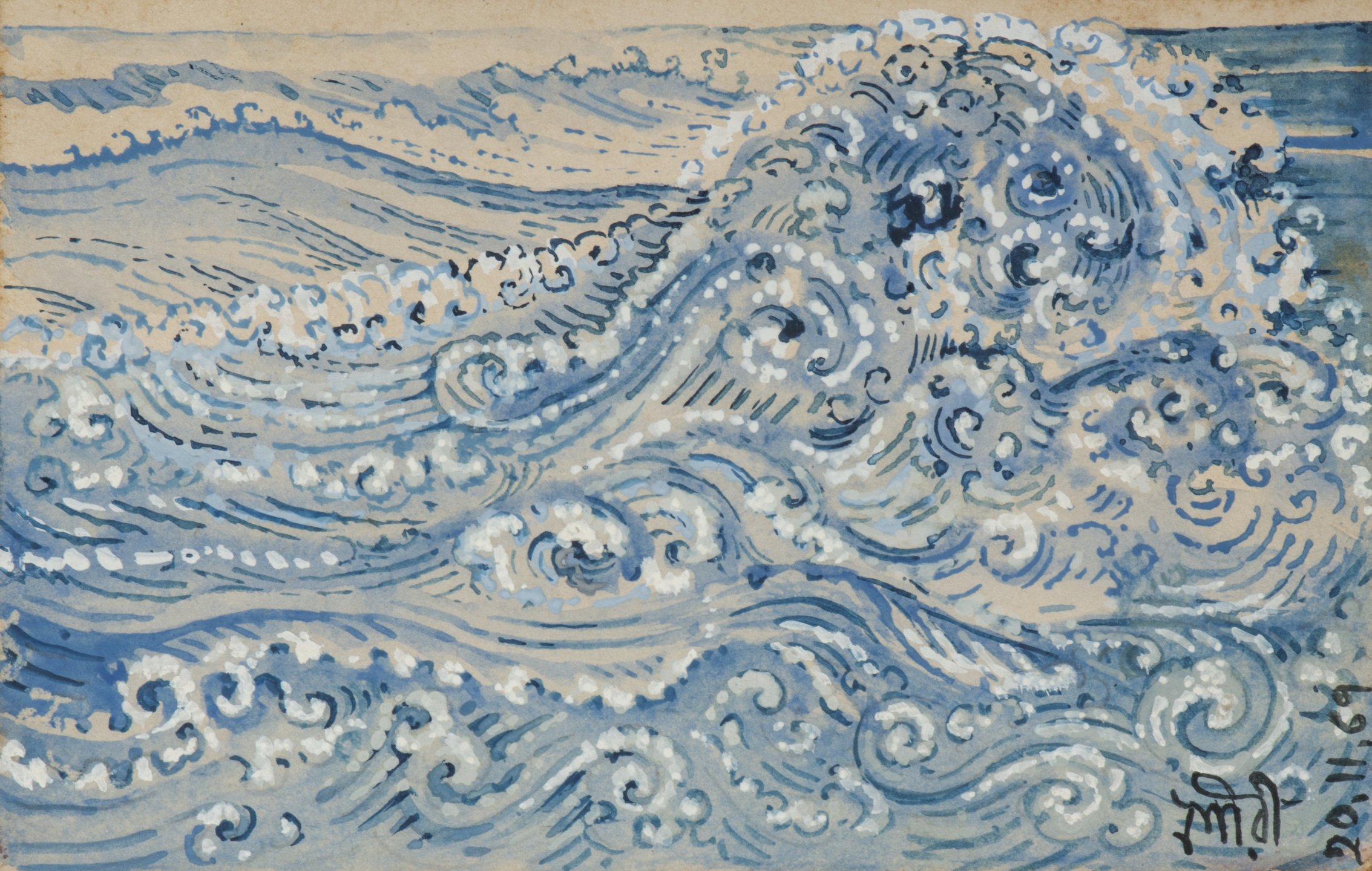
Crafting Visions: The Art of Gouri Bhanja
July 19 - August 16, 2025 at Akar Prakar, Kolkata
Gouri Bhanja, a pioneering artist and designer from Santiniketan, stands as a transformative figure in 20th-century Indian art.
Adevoted student of Kala Bhavana, she brought together formal training, folk tradition, and design innovation to build a body of work that exemplified the Santiniketan ethos—where life and art were in constant, meaningful dialogue.
One of Gouri Bhanja’s most significant contributions was her reimagining of alpana, a traditional Bengali floor art form. While rooted in ritual and domestic spaces, Gouri elevated alpana into a dynamic visual language that found expression in murals, stage design, festival décor, and educational contexts. Her work preserved the spontaneity and rhythmic quality of hand-drawn forms while avoiding mechanical repetition. In her hands, the line “thought”—it danced across space, embodying motion and meditative clarity. This was not merely a revival of tradition but a radical repositioning, much like the Bauhaus’ elevation of textiles through modern design logic.
Gouri's parallel exploration of batik marked another milestone in her career. After Rabindranath Tagore’s 1927 journey to Java, which introduced the intricate dyeing techniques of batik to Santiniketan, Gouri became a key figure in integrating these motifs into applied art. Drawing from the tools, samples, and knowledge Tagore brought back, Gouri conducted experiments in design, colour, and technique. Her own batik works reflected the layering and depth unique to the form, blending indigenous craftsmanship with global aesthetic conversations. In this way, she became a cultural bridge between India’s living crafts and the broader modernist world.
Her creative spirit extended far beyond technique. Gouri Bhanja saw everyday life—particularly the often-invisible labour and emotion of women—as a subject worthy of aesthetic attention. Whether it was women multitasking in domestic spaces or the quiet rhythms of rural life, her work documented and dignified the inner worlds of the marginalized with empathy and refinement. This feminist dimension—quiet but powerful—made her work deeply relevant in discussions of gender and visual culture.
Gouri's understanding of art was also shaped by the Ajanta murals, a legacy she inherited from her father, master moshai Nandalal Bose, who also saw Ajanta as a spiritual and formal foundation for Indian art, Gouri brought those principles into her design vocabulary. She adapted Ajanta’s motifs for textiles, breaking free from static traditions and infusing new energy into applied arts. Her floral and faunal studies—from nagkesar to dolonchampa—demonstrated a refined ability to move from observation to stylization, echoing the very Santiniketan principle of design rooted in nature.
Her influence was not limited to the visual arts alone. Gouri was one of the key contributors to the illustration and visual design of the Indian Constitution, working alongside Nandalal Bose and other Santiniketan artists. This monumental project symbolized the merging of art with nation-building—a rare moment where design became both sacred and civic. Her hand shaped not just decorative margins but the visual identity of a newly independent India.
Gouri also stepped into the world of performance. In Rabindranath Tagore’s dance-drama Natir Puja, she performed with such expressive grace that Tagore himself praised her. Her stage work demonstrated her understanding of space, movement, and rhythm—not just in design but in embodied performance. This reflected her integrated approach to the arts: visual, performative, and spiritual.
Her contributions were deeply tied to Santiniketan’s broader vision, which aimed to bring together art and life, aesthetics and ethics, tradition and innovation. Influences like Austrian art historian Stella Kramrisch further enriched this environment, offering European perspectives on the unity of form and meaning. Gouri absorbed and transformed these dialogues into a practice that was deeply personal yet universally resonant.
In shaping the design traditions of Karu Sangha, in training future generations of craftspersons and artists, and in creating works that merged ritual with modernity, Gouri Bhanja proved that women’s art, domestic art, and craft-based practices could not only survive within high art contexts—they could thrive, redefine boundaries, and enrich the cultural fabric of the nation.
Gouri Bhanja’s legacy continues to live on—not just in archives and collections, but in the rhythms of everyday art that remain alive in Santiniketan, and in the imagination of artists who believe in the power of line, form, and tradition to tell deeper human stories.
-Debdutta Gupta
Self Portrait, Kala Bhavana | Pencil sketch on card | 5.5 x 3.25 in | 1939
The silence of Arrival | Pen and ink on card | 6 x 4.25 in
When we met on the way | Pen and ink on card | 6 x 4.25 in | 1956
Untitled | Watercolour on card | 3.5 x 5.5 in
The silence of Arrival | Pen and ink on card | 6 x 4.25 in
She Who Offers | Pencil on card | 6 x 4.25 in
Tara | Tempera on card | 26.5 x 15.25 in | 1955
The Singing Slopes | Watercolour on card | 3.25 x 5.25 in | 1969
Surjomukhi (Sunflower) | Tempera on masonite board | 5 x 3.25 in | 1942
Shyama | Tempera on card | 13 x 8.75 in
Rhythm of the sea | Wash on card | 3.25 x 5.25 in | 1959
Pujarini | Tempera on card | 14.25 x 19 in
Natir Puja | Tempera on card | 20.75 x 9.75 in
Kurma Avatara | Wax Batik on fabric | 38 x 17.25 in
Krishna & Gwalinis | Tempera on paper pasted on brown Nepali handmade | 16.5 x 9.75 in | 1959
Kopai | Tempera on paper | 4.75 x 11.75 in
Putul Khela | Mixed media | 3.25 x 5.5 in
Joba (Study and Composition) | Tempera on card | 3.25 x 5.25 in
Gharer pathe (way to home) | Ink and watercolour on card | 5.5 x 3.25 in
Flower Study at Kala Bhavana | Watercolour on card | 5.5 x 3.25 in | 1959
Egyptian Queen | Applique work (Tempera background) on fabric | 53.25 x 20.5 in
Barsha (Rainy season) | Tempera | 4.5 x 90.5 in
Flora (Study and Stylization) | Tempera on card | 5.25 x 3.25 inches | 1969
Flora (Study and Stylization) | Tempera on card | 5.5 x 3.5 in | 1956
Gouri Bhanja (1907-1998)
Gouri Bhanja was born on 20 January 1907 in Kharagpur, then part of Monghyr District in Bihar, to the celebrated artist Nandalal Bose and Sudhira Bose. Raised in the artistic and intellectually vibrant environment of Santiniketan, she received her early training in the arts under the close mentorship of her father. In 1926, at the invitation of Rabindranath Tagore, she performed as the lead dancer (nati) in his iconic dance-drama Natir Puja, staged at Santiniketan. The following year, in 1927, she married Santosh Kumar Bhanja (Chowdhury), a lawyer, and spent a few years in Madras (now Chennai), where she also contributed to art education before returning to Santiniketan.
By the 1930s, Gouri began teaching at Kala Bhavana, the art institute of Visva-Bharati. Alongside her sister Jamuna Sen, she became a pioneering instructor in indigenous art and crafts. Her practice included alpana (ritual floor-painting), kantha embroidery, mural and wax-resist Batik. She is widely credited with introducing Batik art at Kala Bhavana, where she worked extensively on its technique and design. Her name was officially recorded in Visva-Bharati's faculty list in 1942, confirming her position as an art educator of high repute.
Between 1949 and 1950, Gouri played a significant role in the illumination of the original handwritten Constitution of India under Nandalal Bose’s leadership. One of her notable contributions was the Chola-style depiction of Nataraja, featured in the Constitution’s calligraphic manuscript adopted on 26 January 1950. In the early 1950s, she also collaborated with artist Haimanti Devi on translating a Dutch manual on Batik techniques and painted a devotional gouache titled Pujarini, which, according to later accounts, received praise from Abanindranath Tagore.
In 1954, she designed the alpana for the Santiniketan float at the Republic Day Parade in New Delhi and in 1955 for the inauguration of the Massanjore (Tilaiya) Dam. Her ceremonial floor paintings were also integral to events such as Congress sessions in Kalyani and Durgapur, and annual festivals at Santiniketan like Nababarsha, Rabindra Jayanti, and Basantotsav. Gouri Bhanja passed away on 6 November 1998 at the age of 91, leaving a legacy of innovation in traditional craft and art pedagogy.


























